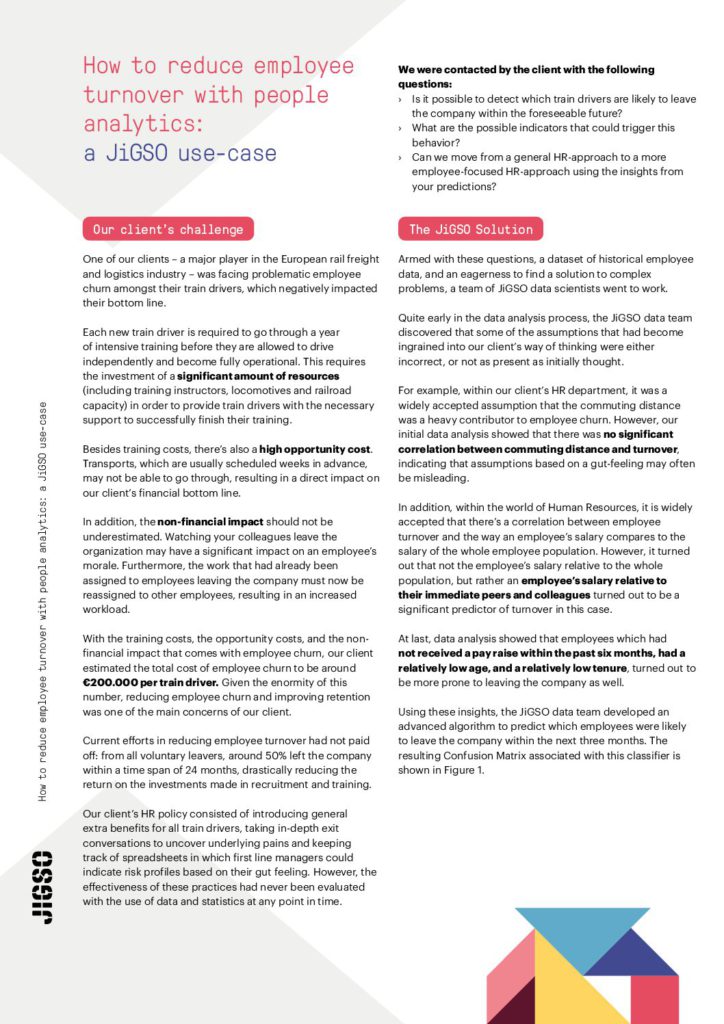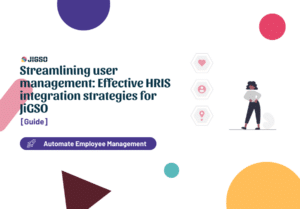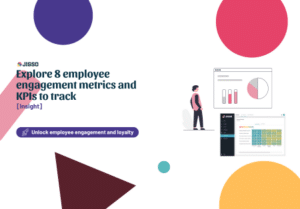Employee turnover is an issue many organisations face. Besides a significant negative impact on your bottom line, there are also non-financial consequences such as lower employee morale and brand image. Together with one of our clients, a major player in the European rail freight and logistics industry, we investigated how people analytics can help reduce employee turnover.
Read the full article below or download the pdf.

Our client’s challenge
One of our clients – a major player in the European rail freight and logistics industry – was facing problematic employee churn amongst their train drivers, which negatively impacted their bottom line.
Each new train driver is required to go through a year of intensive training before they are allowed to drive independently and become fully operational. This requires the investment of a significant amount of resources (including training instructors, locomotives and railroad capacity) in order to provide train drivers with the necessary support to successfully finish their training.
Besides training costs, there’s also a high opportunity cost. Transports, which are usually scheduled weeks in advance, may not be able to go through, resulting in a direct impact on our client’s financial bottom line.
In addition, the non-financial impact should not be underestimated. Watching your colleagues leave the organization may have a significant impact on an employee’s morale. Furthermore, the work that had already been assigned to employees leaving the company must now be reassigned to other employees, resulting in an increased workload.
With the training costs, the opportunity costs, and the nonfinancial impact that comes with employee churn, our client estimated the total cost of employee churn to be around €200.000 per train driver. Given the enormity of this number, reducing employee churn and improving retention was one of the main concerns of our client.
Before: generic HR strategy
Current efforts in reducing employee turnover had not paid off: from all voluntary leavers, around 50% left the company within a time span of 24 months, drastically reducing the return on the investments made in recruitment and training.
Our client’s HR policy consisted of introducing general extra benefits for all train drivers, taking in-depth exit conversations to uncover underlying pains and keeping track of spreadsheets in which first line managers could indicate risk profiles based on their gut feeling. However, the effectiveness of these practices had never been evaluated with the use of data and statistics at any point in time.
We were contacted by the client with the following questions:
- Is it possible to detect which train drivers are likely to leave the company within the foreseeable future?
- What are the possible indicators that could trigger this behavior?
- Can we move from a general HR-approach to a more employee-focused HR-approach using the insights from your predictions?
The JiGSO solution: reduce turnover with people analytics
Armed with these questions, a dataset of historical employee data, and an eagerness to find a solution to complex problems, a team of JiGSO data scientists went to work.
Quite early in the data analysis process, the JiGSO data team discovered that some of the assumptions that had become ingrained into our client’s way of thinking were either incorrect or not as present as initially thought.
For example, within our client’s HR department, it was a widely accepted assumption that the commuting distance was a heavy contributor to employee churn. However, our initial data analysis showed that there was no significant correlation between commuting distance and turnover, indicating that assumptions based on a gut-feeling may often be misleading.
In addition, within the world of Human Resources, it is widely accepted that there’s a correlation between employee turnover and the way an employee’s salary compares to the salary of the whole employee population. However, it turned out that not the employee’s salary relative to the whole population, but rather an employee’s salary relative to their immediate peers and colleagues turned out to be a significant predictor of turnover in this case.
At last, data analysis showed that employees which had not received a pay raise within the past six months, had a relatively low age, and a relatively low tenure turned out to be more prone to leaving the company as well.
Using these insights, the JiGSO data team developed an advanced algorithm to predict which employees were likely to leave the company within the next three months. The resulting Confusion Matrix associated with this classifier is shown in Figure 1.

This figure shows that from the total of 524 train drivers, our algorithm predicted a selection of 29 employees to exhibit a higher chance of leaving the company within the foreseeable future. It turned out that from these 29 cases, 22 employees did eventually leave the company within three months after this prediction was made. Taking into consideration that the number of actual leavers was equal to 27 employees, our algorithm showed that it was capable of making a prediction with a high true positive rate, whilst keeping the false positive rate rather low.
The value to the customer
How has this solution ultimately benefited our client?
First, reoccurring turnover predictions allow our client’s HR department to streamline their efforts towards employees which exhibit a higher chance of leaving the company within the near future, enabling them to become more effective in reducing turnover rates.
Second, the insights generated by the predictive model allows the HR department to tackle the hurdles of individual employees with programs that are uniquely tailored to their needs. Instead of using a general – usually less effective – approach. Again, allowing the HR department to become more effective in reducing employee churn.
Finally, taking into consideration the cost that is associated with hiring and training a new employee, using predictions like this in an insightful way – and preventing some of these employees from leaving the company – will have a profound impact on our client’s financial bottom line.



